How do Hashtags Work? Guide for 2025
Table of contents
Hashtags were born on Twitter. How did that happen? In its early days, Twitter did not support the hashtag feature. Users complained that it was a bit hard to see relevant content. Chris Messina started to look for a solution. In August 2007, he wrote the very first (and famous) Twitter hashtag. He simply asked other users what they felt about using # (pound) to classify groups. They enjoyed it a lot.
After that, we had to wait till 2009, when Twitter presented a search tool that allowed users to check who else was using a particular hashtag. The following year Twitter introduced the Trending Topic feature that displays the most popular hashtags in real-time.
Since that day, many social media platforms have noticed the hashtags’ potential and implemented them. So today, we can use them on Instagram, LinkedIn, Facebook, YouTube, and many more.
No matter the context, hashtags have always served one purpose — to connect, build a network of connections, and spread the message. Hashtags have quickly caught on and have been used by presidents, artists, celebrities, average Internet users, and what’s more important here — by marketers.
Indeed, the hashtag has become so ubiquitous that it’s hard to imagine that there was a time before the hashtag.
What is a hashtag?
A hashtag is a word or phrase preceded with the hash sign (#), used to categorize the accompanying text in social media posts on Twitter, Instagram, Facebook, LinkedIn, and YouTube. At the same time, hashtags enable a search within by clicking them.
Brand24 is a tool that tracks and analyzes hashtags. Try it during a 14-day free trial!
Hashtag history
It’s impossible to provide an exact moment in history where the hash sign came into being. However, we can easily tell when the pound sign became a hashtag.

The pound symbol
Another story says that typewriter keyboards shared the “number three” key with the monetary symbol of the pound, which later became the hashtag symbol. If you look at your keyboard, you’ll notice that the number three shares one key with the hash sign.
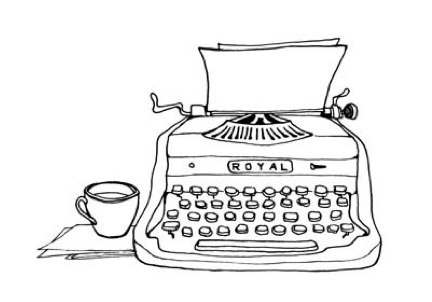
The octothorpe
Some say it all started in Bell Laboratories in the 1960s when Bell worked on the Touch Tone technology that introduced two new buttons. Research conducted on the public revealed that people would see there the asterisk and the hash sign. What’s interesting, the “hash sign” key in the Bell days was known as “octothorpe” – named after an athlete, Thorpe.

IRC
As the hash sign made it to computer keyboards, the Internet Relay Chat was created. IRC was one of the first online communicators and used the hash sign to group conversations about certain topics – it’s just like Slack channels these days.

Hashtag
Chris Messina, a heavy user of the IRC chat and Twitter employee, came up with this idea of gathering all relevant tweets in one place, under one… #hashtag. That is how hashtags came into being and later spread to other social media platforms – Facebook, Instagram, Twitter, and LinkedIn.

How do hashtags work?
- First of all, hashtags work primarily on social media platforms like Facebook, Instagram, Twitter, LinkedIn, and YouTube.
- They group, tag, and connect a social media post to a topic expressed by the hashtag, for example, #cycling.
- At the same time, hashtags are clickable and enable a search within them.
- By using relevant hashtags, you can join conversations, browse content and let your content be found on social media.
Here’s one funny explanation of how hashtags work:
Hashtags in social media
As what became known on Twitter as a hashtag has been adapted by other social networks: Facebook, Instagram, YouTube, and LinkedIn.
Even though hashtags across these social media networks are supposed to work the same, they work differently due to how each social network works.
Here’s how hashtags work on particular social media platforms.
Hashtags on Twitter
Hashtags are important for Twitter users. It all started with the tweet from Chris Messina I mentioned at the beginning. Hashtags on Twitter are mostly used in group conversations about a topic.
Just as you can find conversations under a hashtag, other Twitterers can find your hashtagged content. This is how you can join or start a conversation.
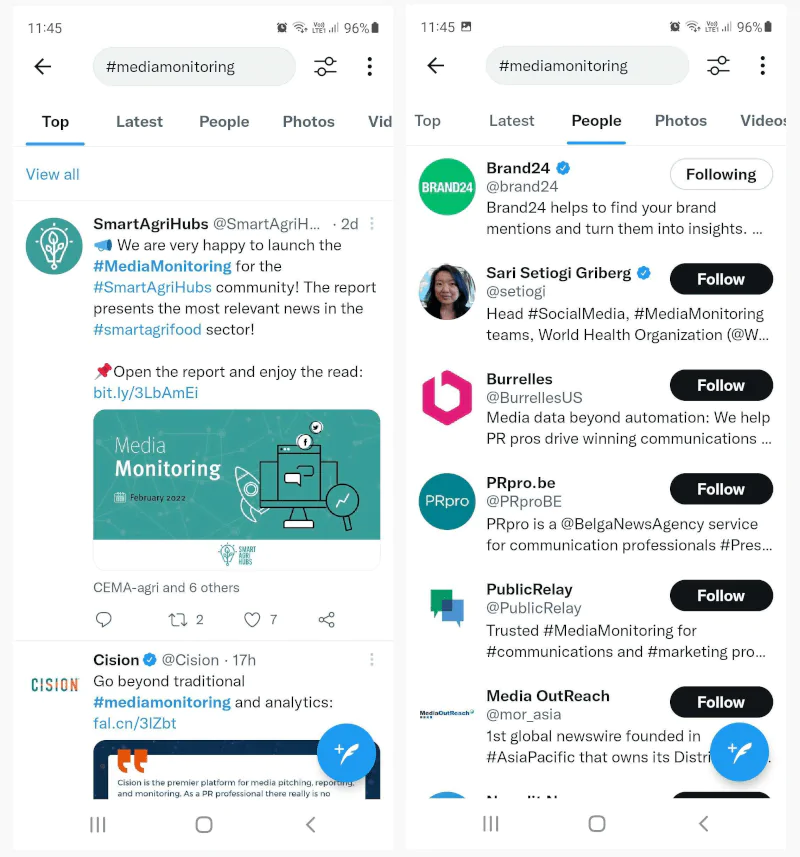
Each Twitter account, including yours, once you log in, displays a list of relevant trending hashtags. They are based on accounts you follow and your location.
You can click every single one of them and delve deeper into conversations about a topic.
Also, you can manually look into any hashtag you want. To do so, you need to use Twitter’s internal search. Once you search for your hashtag, Twitter returns the latest and the most engaged tweets using this hashtag.
What’s more, you can browse top accounts to follow, latest tweets, accounts, photos, videos, news, and broadcasts mentioning your hashtag.
Unfortunately, we can not follow hashtags because Twitter doesn’t offer such an opportunity. Nevertheless, here are 3 easy methods to follow a hashtag on Twitter using a social media monitoring tool.
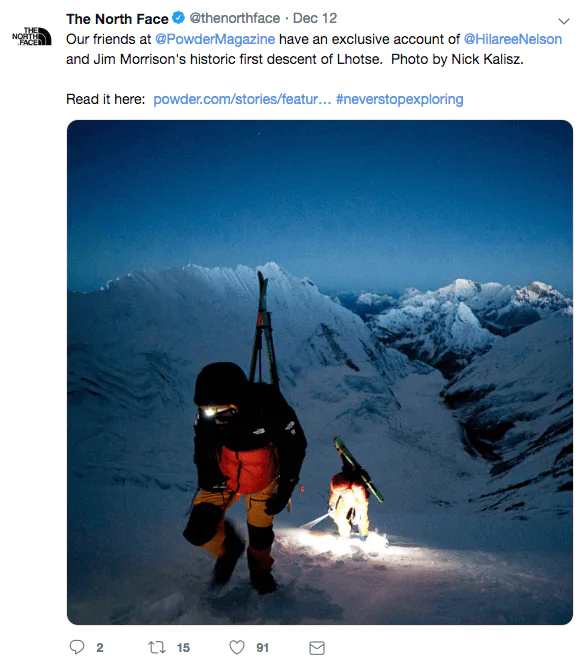
Brand24 is a tool that allows following any hashtag on Twitter in real-time.
Learn: How to Find Trending Hashtags on Twitter
Hashtags on Facebook
Facebook doesn’t support hashtags as much as Twitter or Instagram. Hashtags there work only on public profiles, fan pages, or groups. This is because of privacy settings.
If a Facebook user really values privacy and hides his or her posts and activities from the public, any hashtagged content is untrackable to other users and the internal search engine.
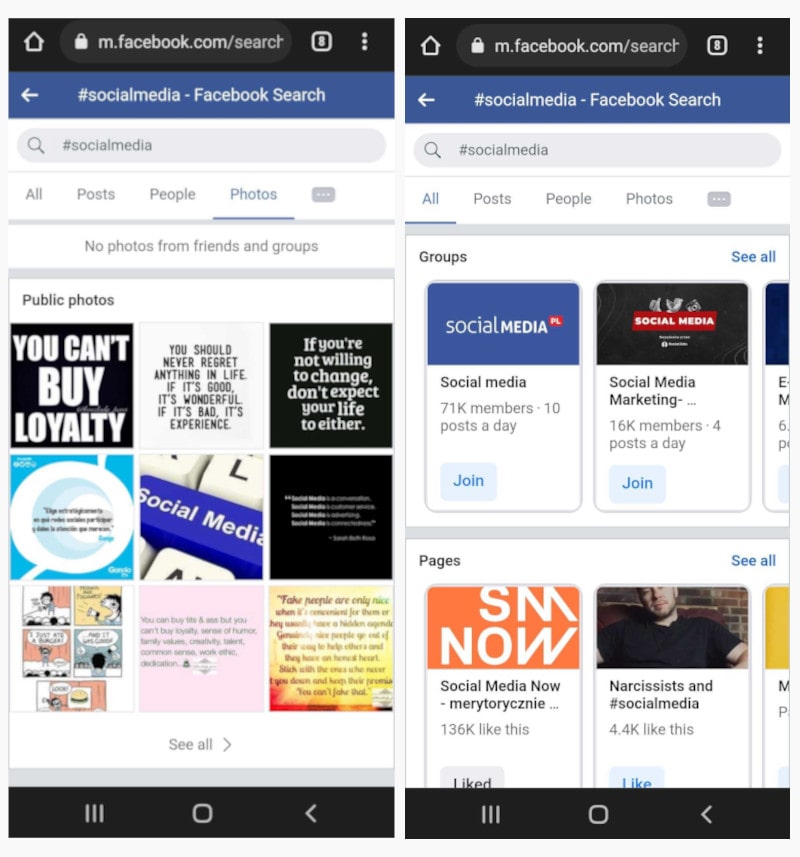
In any other case, you can look up hashtags in Facebook’s internal search – it works when it comes to public profiles – company, celebrity, brand, and other fan pages.
Then, search results are influenced by your Facebook friends and the pages you like.
To be honest, hashtags on Facebook don’t actually matter unless you run a hashtag marketing campaign. Still, if you’re a marketer, it’s worth tracking hashtag performance on Facebook. Is it worth to use hashtags on Facebook? You need to test it.
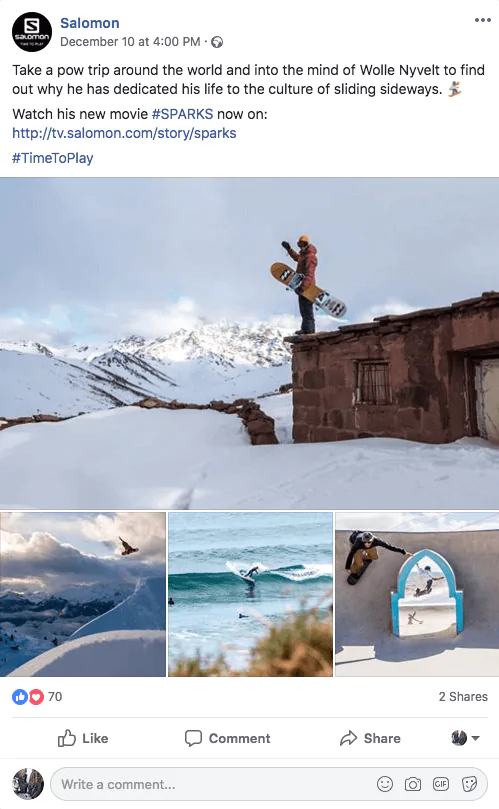
In case you would like to experiment with Facebook hashtags, read our article: How to Find Trending Hashtags on Facebook
Hashtags on YouTube
Hashtags appeared on YouTube in 2016. They fulfilled their original purpose, which was to categorize the video content.
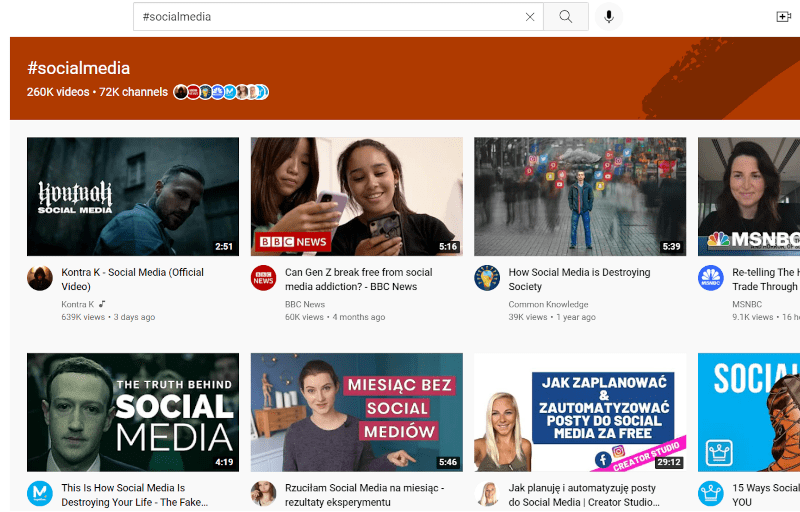
Hashtags on YouTube can be used in titles, descriptions. Now, apart from these places, YouTube videos can be hashtagged and categorized to provide users with even more relevant results.
Hashtags on YouTube in the video description are clickable and let you explore a topic deeper, beyond the old search engine. We can not subscribe to hashtags.
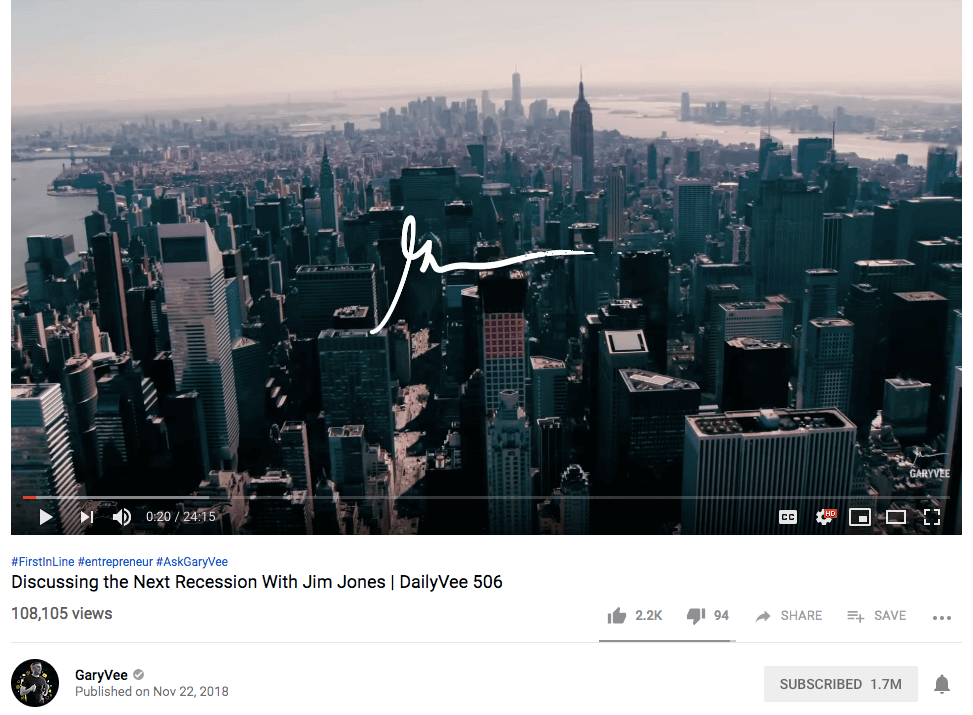
Hashtags on Instagram
Another social media platform to adapt hashtags was Instagram – a photo-sharing platform that quickly won the hearts of those who think an image is worth a thousand words.
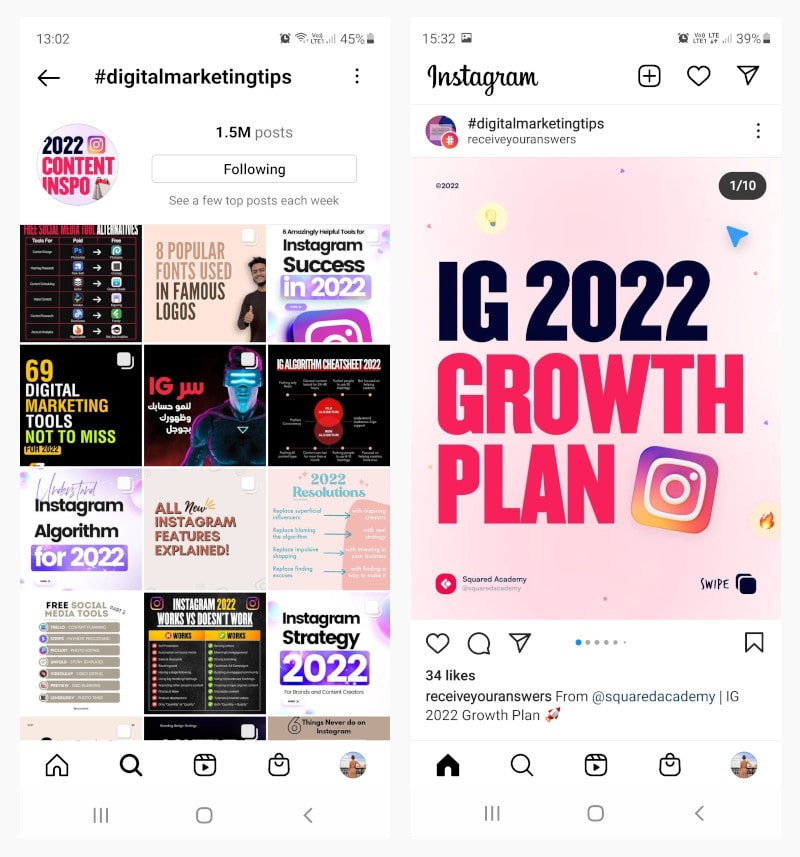
On Instagram, hashtags are crucial to growing your audience. If you posted an Instagram post without hashtags, your post would reach only your followers – there’s no chance new people will see your post.
Thanks to hashtags, your posts get discovered and appear on the Explore page – other Instagrammers can find you there.
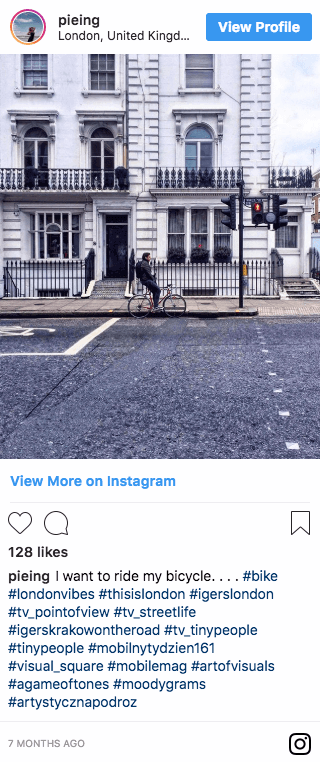
Without hashtags, it’s challenging to grow your account.
You can browse other Instagrammers’ content using the Explore page or by following a hashtag. The Instagram posts you can browse on the Explore page are based on the accounts, hashtags you follow, or browse.
The biggest win you can have on Instagram is if you make it to the Explore page – it depends on a few factors, for example, using trending hashtags. Learn how to find trending hashtags on Instagram.
Learn more about Instagram hashtag analytics.
Hashtags on LinkedIn
Last but not least, beginning 2018, hashtags are now on LinkedIn, too. LinkedIn hashtags help users reach relevant topics and offer the opportunity to join relevant conversations.
We have lots of ways to filter the hashtags. We can search for them across posts, companies, people, jobs, groups, schools, events, courses, and services.
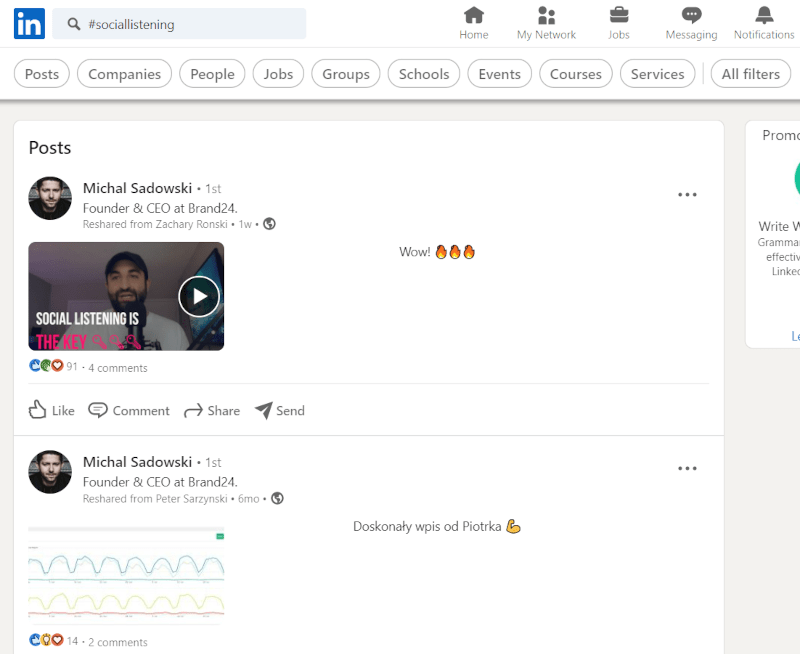
There’s a lot you can do with LinkedIn hashtags – join conversations, start conversations, add hashtags to articles on LinkedIn Pulse, or even follow hashtags.
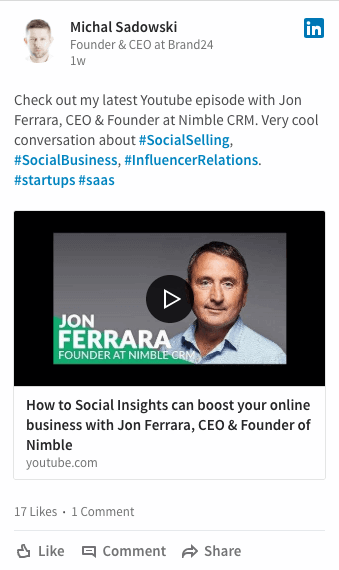
Brand24 is a tool that finds the right hashtags from your business niche.
Types of hashtags
To use hashtags properly and implement them in social media strategy successfully, you need to know what type of tags are the most valuable. But that’s everything. It’s essential to use relevant and popular hashtags.
I encourage you to read the list below and think about implementing them into your hashtag strategy.
01 Daily hashtags
It seems that days of the week influence now both human and hashtag life. Each day of the week celebrates something you can share on social media and get it hashtagged: Monday – #MondayMotivation, #MondayBlues; Tuesday #TravelTuesday; Wednesday – #WisdomWednesday; Thursday – #ThrowbackThursday; Friday – #TGIF; Saturday – #SaturdayNightFever; Sunday – #SundayFunday.
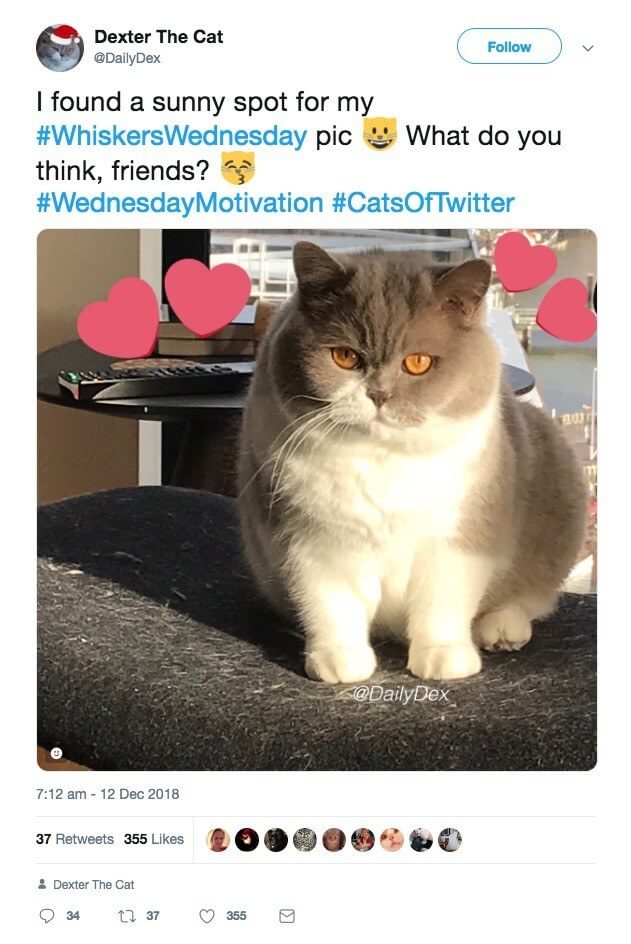
The year is full of holidays, celebrations, and festivals – every day there’s something to celebrate, be it International Country Music Day, Cat Day, Pizza Day, or Programmer’s Day. Who established these days? I have no idea but I can tell you that they get hashtagged, too, for example, #IndependenceDay, #WorldPhotographyDay, #WorldSleepDay.
02 Branded hashtags
Branded hashtags are of interest to companies, marketers, social media managers, and consumers particularly attached to brands. For marketers, those kinds of hashtags are a must – it’s a way to expand the company’s social media presence, reach potential customers, and spread brand awareness.
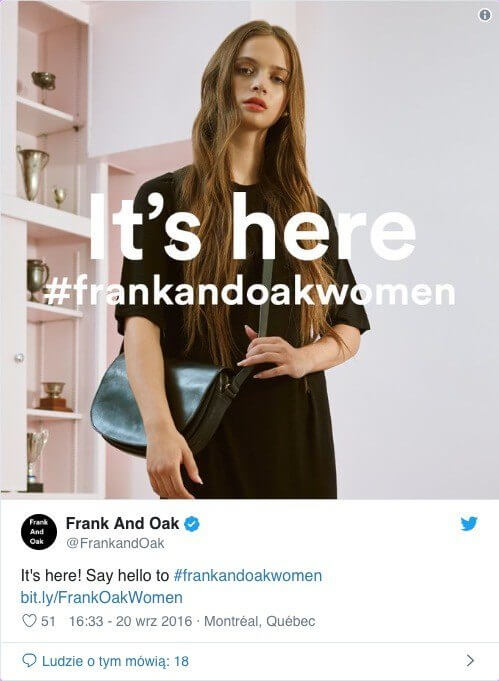
What’s more, branded hashtags allow marketers to measure their marketing activities: contests, marketing campaigns, or brand awareness. Hashtag analytics provides plenty of data about hashtags that can be used to estimate a company’s marketing performance.
03 Marketing hashtags
Companies big and small use hashtags to support their marketing campaigns. How do these hashtags help them in this area? Well, there are a few ways hashtags support marketing campaigns.
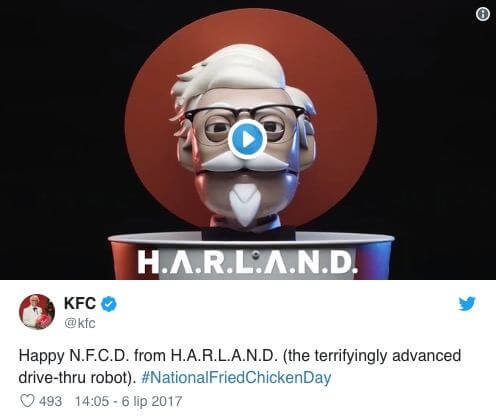
First of all, companies running marketing campaigns use dedicated hashtags to spread awareness about the company. The more consumers in social media see the hashtag, the bigger the chance it grabs their attention, engages, turns into customers.
Secondly, companies create hashtags to encourage customers to participate, engage and create content. This is how they get user-generated content that works just like social proof and endorsement.
Lastly, hashtags in marketing campaigns help companies measure the effectiveness of their marketing actions.
04 Niche hashtags
Each of us is a niche. What’s yours? I’m into #cycling, #travel, #foodporn and #ContentMarketing. Niche hashtags are used to reach and join conversations about specific topics relevant to you. Remember that it’s much more than just #NicheNameHashtag – each niche has much more hashtags within you should use to make your content trending and reach a wide audience.
Wedding hashtags, startup hashtags, Wednesday hashtags, fashion hashtags, or food hashtags hold even more hashtags within these categories. Here’s a few words on how to find hashtags for your niche on Instagram.
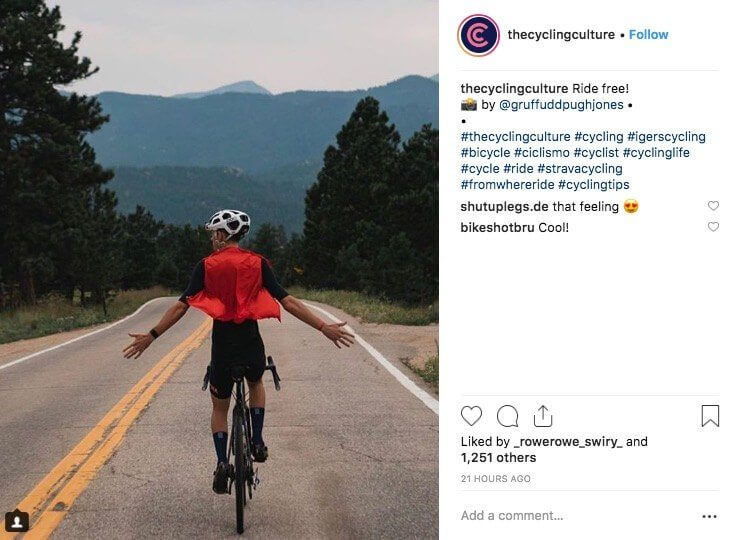
05 Location hashtags
These hashtags are used to describe a location you are or were in. Location hashtags are often just names of places but some of them, keen on marketing places, have dedicated hashtags. One example can be the city Manchester which encourages people to use the #ManCity hashtag.
Location hashtags are particularly important for the tourist industry – if they want to be found and whet the appetite of travelers, they should use the trending hashtags connected to the place.
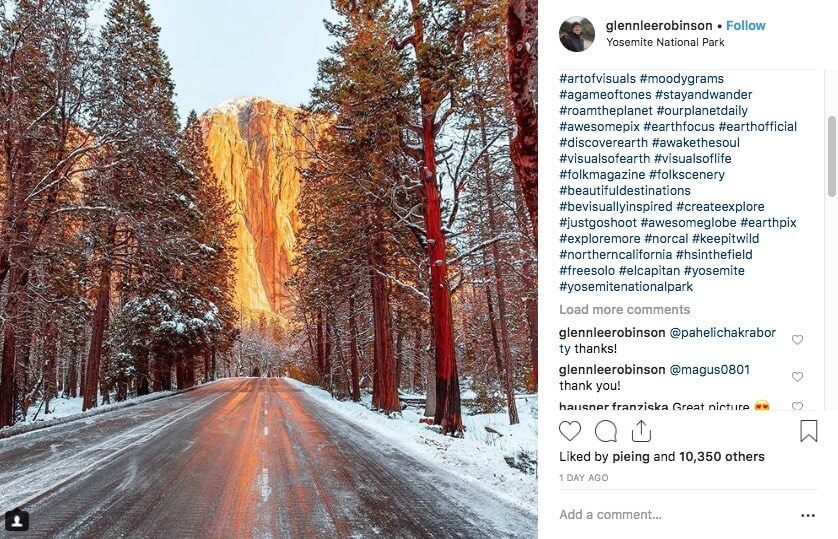
Location hashtags are also important for outdoor photographers – if they want their work to be found by a wider audience, they should also use trending hashtags describing the place the photo was taken in.
06 Event hashtags
Conferences, events, sports, etc. – they all use event hashtags. Event hashtags spread the word about the event before, during, and after the event – the longer it exists in social media, the more people it reaches. It can translate into bigger attendance, increased social media buzz, more sponsors, or bigger media coverage.
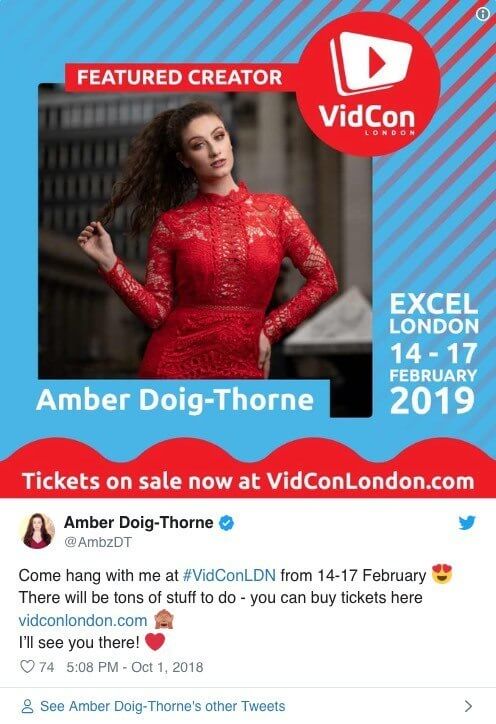
Event hashtags boost engagement and social media reach during an event as participants share photos, opinions, and discuss in social media topics connected to the conference. Event hashtag helps participants ask questions in case of problems – an event manager is then able to respond momentarily and help out.
Again, the event hashtag helps measure the social media impact of an event: social media reach, engagement, the volume of mentions of the most influential social media authors. On the basis of these metrics, you can measure the social media performance of the event.
07 Community hashtags
At first sight, community hashtags might look like niche hashtags. The truth is, they are entirely different. While niche hashtags simply represent some areas of life, such as sports, hobbies or industries, community hashtags are created to serve certain communities gathered around, for example, products, influencers, brands or any other, more specific theme. For example, if a person uses a Canon camera to take photos, he or she can use the #canonshooter hashtag.
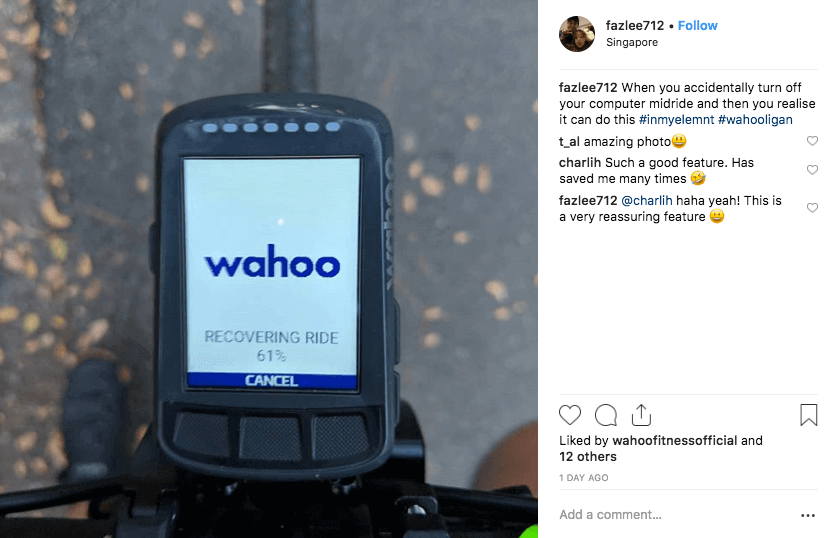
08 Contest hashtags
One social media tactic to boost engagement around a company is to run a social media contest. It’s a great way to reach a new audience. Social media contests include using a hashtag to spread awareness, get more people involved, and find all participants of the contest.
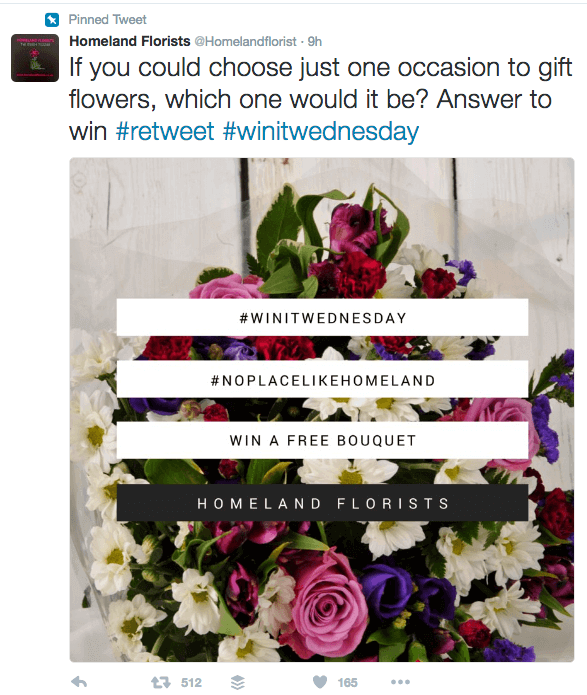
Five most iconic hashtags of all time
#IceBucketChallenge
Remember these videos of people pouring buckets of ice-cold water over themselves? It was the #IceBucketChallenge. It all started from ALS (amyotrophic lateral sclerosis) sufferer, Pete Frates as a fundraising campaign that from the closest circle of acquaintances went viral all over the Internet and involved celebrities, scientists, actors and other popular and influential people. Here’s Bill Gates taking part in the challenge and nominating other great minds.
#JeSuisCharlie
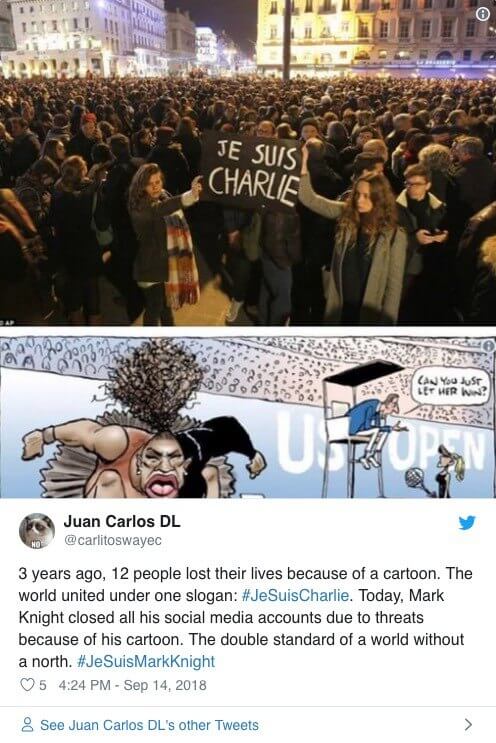
This hashtag was created to commemorate the victims of a terrorist attack carried out on journalists of Charlie Hebdo, a French satirical newspaper. The slogan that evolved into one of the most iconic hashtags ever was also to support the freedom of speech – the newspaper was known for satirical images and Muslim caricatures which probably made it the target.
#TheDress
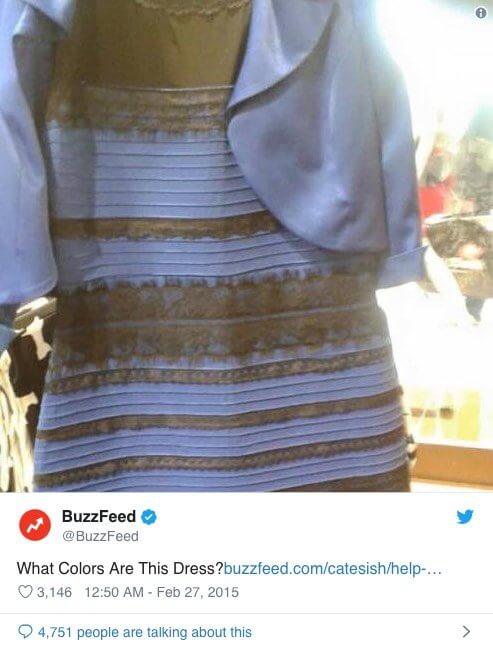
Thursday, February 26th, 2015. Social media went crazy over a dress. It all started at a wedding. The bride’s mother asked her daughter for an opinion about the dress. The daughter disapproved of the dress, so the mother sent it to tumblr’s swiked, Caitlin McNeill, whose band was to play at the wedding. Swiked then published the image to tumblr, and this is where it all started.
Soon after, the dress became #TheDress and roughly 20 minutes after the post, Twitter reported that the hashtag get’s 5,000 tweets per minute which was just a start. That’s correct – arguing about the color of a dress has become one of the most viral hashtags ever.
#CupForBen
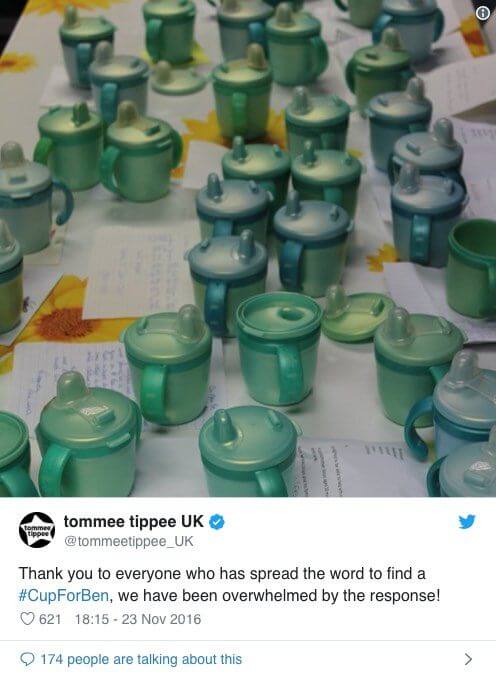
In 2016, Twitter saw a touching story of Marc Carter and his autistic son. The little man has been sipping his drinks from the same Tommy Tippee blue cup since a kid. Because Ben doesn’t like to drink out of any other cup, and the production of the cup was down, his dad got worried when the favorite cup began to fall apart.
Marc tweeted asking people about a spare cup and used the #CupForBen hashtag. The message spread and reached Tomee Tippee which decided to help out. A team found the original design of the cup and produced 500 cups for Ben so that he would never run out of them.
#BlackLivesMatter
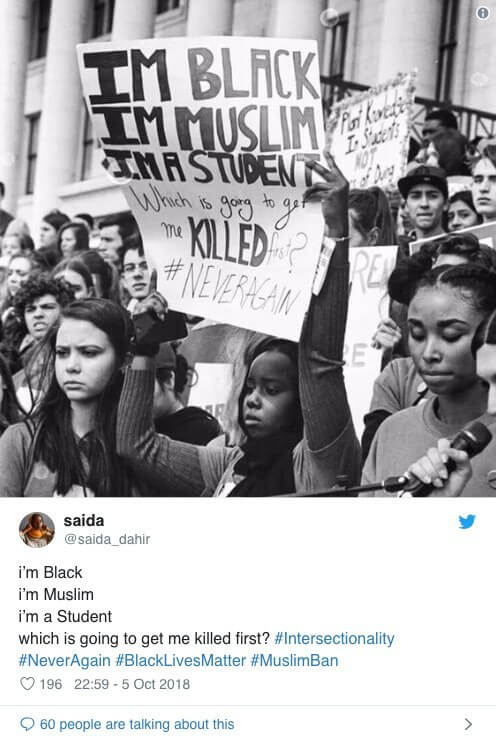
Another memorable hashtag supported in social media a movement. #BlackLivesMatter was created after a neighborhood watch coordinator shot to death a 17-year-old boy of African-American origin. Since then, the hashtag has been massively used to raise awareness about racism. According to ADWEEK, since July 2013, the hashtag has been used 30 million times on Twitter.
Conclusion
It’s hard to imagine social media marketing without hashtags. They help marketers evaluate social media campaigns, gain a wider reach, promote events and create memorable marketing actions, and many more.
Types are important, but using relevant hashtags that match your target audience is even more critical. On the other hand, using too popular hashtags, such as #love, #food, or #girl might not be effective. That’s because millions of people add them to their social posts. So your content will probably be lost in the crowd.
How to run an influential hashtag strategy? Check our article about Hashtag Marketing.
FAQ
1. What happens if you start a hashtag?
When you start a hashtag, you’re creating a unique identifier or keyword that allows social media users to categorize and discover content related to a specific topic or theme. If your hashtag becomes popular, other users will start using it in their posts, making it easier for people to find and engage with content relevant to that hashtag. By following some hashtag tips, like making it memorable, relevant, and easy to spell, you can increase the chances of your hashtag gaining traction.
Read more: Unlock deeper insights with an advanced hashtag counter.
2. Are hashtags still necessary?
Yes, hashtags are still necessary and useful, especially on platforms like Instagram and Twitter. They help users discover and organize content, connect with others interested in the same topics, and increase the visibility of their posts. While some platforms, like Facebook, may not rely as heavily on hashtags, using related hashtags on platforms like Instagram and Pinterest, hashtags can significantly increase your content’s reach and engagement. However, it’s essential to use hashtags effectively by choosing relevant and popular tags without overloading your posts with too many hashtags.
3. Should I use hashtags on every post?
While it’s not mandatory to use hashtags on every post, incorporating relevant and popular hashtags can help increase your content’s visibility, engagement, and reach. Using the same hashtag consistently can also help establish your brand identity and make it easier for users to find your content. However, it’s essential not to overuse hashtags or use irrelevant tags, as this can have the opposite effect and potentially alienate your audience. It’s best to strike a balance by carefully selecting and using hashtags that add value to your posts and resonate with your target audience.


